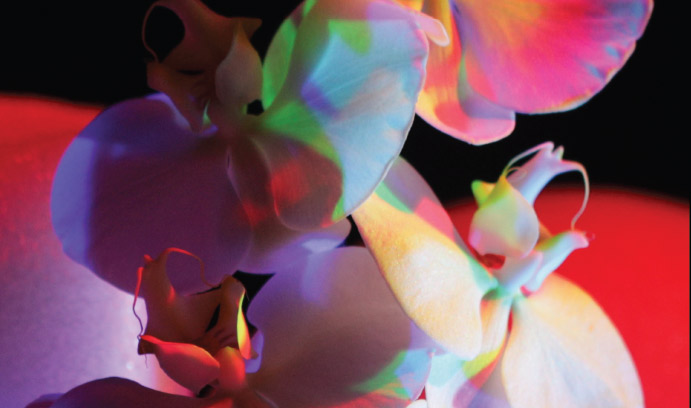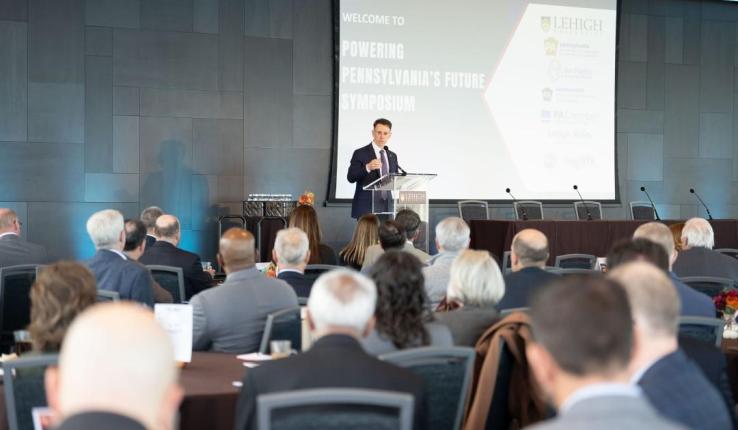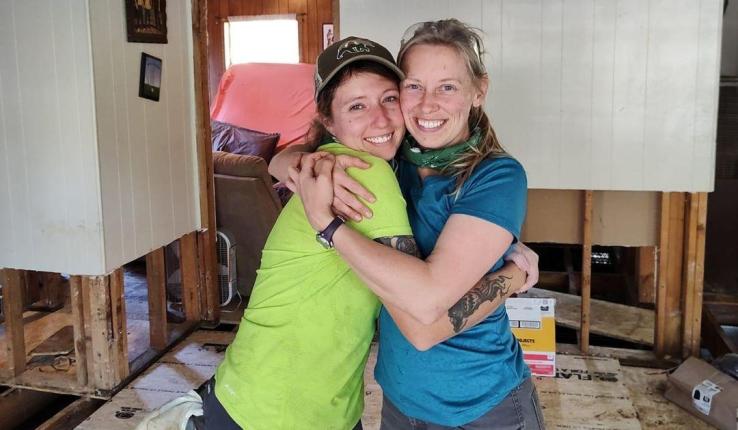Visual Poetry through Theatrical Design

Theatrical designers Melpomene Katakalos and Will Lowry work in neighboring offices on the third floor of Lehigh’s Zoellner Arts Center. It’s not unusual to hear a knock on a shared wall or the shouted description of a sudden stroke of creative genius between the two rooms—evidence of a rich collaborative partnership rooted in a shared affinity for contemporary theatre.
The two came to Lehigh after developing successful professional lives on opposite coasts: Katakalos in the Bay Area, and Lowry in New York.
Katakalos, an associate professor of theatre, has designed sets for the Tony-award winning theatres La Jolla Playhouse and San Francisco Mime Troupe, the California Shakespeare Theatre and Cornerstone Theatre in Los Angeles. She also co-founded the award-winning Crowded Fire Theater Company in San Francisco, which produces works by new and contemporary artists. Lowry, an assistant professor of theatre, spent five years as studio assistant for Tony Award-winning costume designer William Ivey Long, contributing to Broadway productions including Leap of Faith, 9 to 5 and Catch Me If You Can. He has created designs for theatres along the East Coast and as far away as Australia’s famed Sydney Opera House.

Both designers find the greatest amount of excitement in working on new plays and world premieres.
“We have that similar background which allows us to talk with some of the same vocabulary and be excited about the same things,” says Lowry. “That’s one reason I think that it syncs up very nicely.”
Katakalos and Lowry’s outside collaborations influence the suggestions that they bring to Lehigh’s theatre department. Most recently, they’ve put their own creative spin on contemporary productions like Rebecca Feldman’s The 25th Annual Putnam County Spelling Bee, for which Katakalos designed the costumes and Lowry the lighting, and Aaron Posner’s Stupid F*@#ing Bird, which featured a set by Katakalos and lighting by Lowry.
“We’re really similar in lots of ways, but I think we also complement each other,” says Katakalos. “I love creating something and then having someone else do their magic on it and make it look a million times better than I ever could have imagined myself. That’s the best thing about working with really collaborative designers. … You want to work with someone who is excited by the challenges you’ve created. That’s much more exciting. You’ll get a much better play if you do those things.”
Katakalos likens their work to “visual poetry.”
“It’s what playwrights do, in a way,” she says. “Playwrights are distilled, often like poets are. They don’t write a novel, they write a play. It’s 90 minutes, not 500 pages, and I think scenic designers, lighting designers, theatrical designers, we do that as well. We’re creating a visual metaphor for those words.”
That visual metaphor can be different with each version of a particular production, depending on the approach of the designers involved.
“Every designer has a different take and every director has a different take, and that, I think, is the beauty of theatre,” says Katakalos.
“You’re answering a question in your own way, finding your own voice to it,” says Lowry.
A world premiere, however, offers designers the opportunity to do something even more unique: They get to “[answer] a question no one else has answered before because it hasn’t been posed yet,” says Lowry.
“You’re working directly with playwrights who are alive, who are there at the table, who wrote the play and are still writing it—even into previews,” Katakalos explains. “That’s a completely different experience. It’s very exciting as a designer because you get to be part of a creative process that’s quite different. You’re certainly reacting to the work, but you’re influencing it as well by asking questions.”
“Your problem-solving on a [new] play will shape it,” says Lowry. ““There are instances when playwrights rewrite things based on your approach to something they’ve written, which may not have been possible in the literal way, so you collaborate on a new solution.”
Many designers shy away from new works, Katakalos says, because the process presents many unknowns—and often countless redesigns. Those challenges, however, present remarkable opportunities for collaboration.
“I just love that level of collaboration [on a world premiere] where there’s so much trust in the room that anyone can come up with any idea at any moment, and I’m no longer the designer, and you’re no longer the director, and you’re no longer the actor,” Katakalos says. “Those things disappear in those generative moments, in that decision-making, and it’s very exciting. It makes really good art when you do that, when those things are stripped away. You have that trust, and you just want the best play you can make.”
This story appears as "Visual Poetry" in the 2018 Lehigh Research Review.
Posted on:




